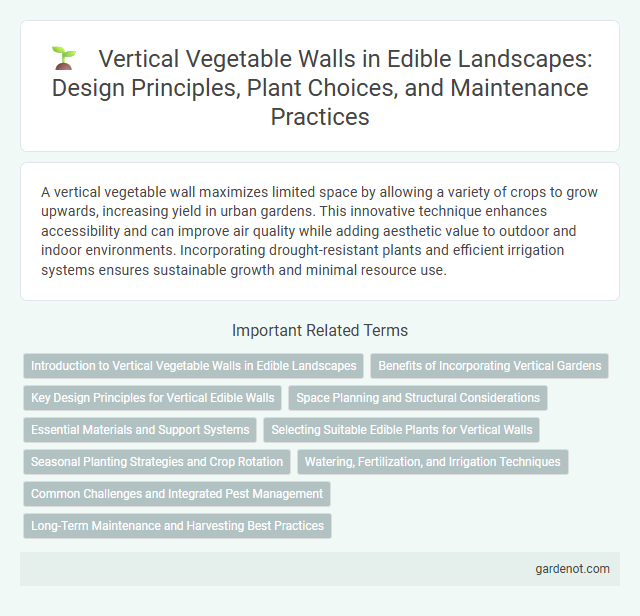A vertical vegetable wall maximizes limited space by allowing a variety of crops to grow upwards, increasing yield in urban gardens. This innovative technique enhances accessibility and can improve air quality while adding aesthetic value to outdoor and indoor environments. Incorporating drought-resistant plants and efficient irrigation systems ensures sustainable growth and minimal resource use.
Introduction to Vertical Vegetable Walls in Edible Landscapes
Vertical vegetable walls maximize space by allowing plants to grow upward on structures, ideal for urban edible landscapes. These walls use modular systems or trellises to support a variety of vegetables such as lettuce, spinach, and herbs while improving air quality and providing fresh produce. Incorporating vertical vegetable walls enhances garden aesthetics, increases yield per square foot, and promotes sustainable food production.
Benefits of Incorporating Vertical Gardens
Vertical vegetable walls maximize limited urban space by allowing the cultivation of diverse crops in compact areas, increasing food production without requiring additional ground area. These gardens enhance air quality through natural filtration and help regulate ambient temperatures, contributing to energy savings. Incorporating vertical gardens promotes biodiversity by providing habitats for pollinators while encouraging sustainable agricultural practices and reducing food transportation emissions.
Key Design Principles for Vertical Edible Walls
Vertical edible walls maximize urban gardening space by incorporating modular, lightweight planting systems that ensure efficient water drainage and root aeration. Selection of drought-tolerant, compact vegetable varieties enhances plant health while minimizing maintenance needs in vertical setups. Integrating automatic irrigation and nutrient delivery systems supports consistent growth and maximizes yield in limited vertical spaces.
Space Planning and Structural Considerations
Efficient space planning for a vertical vegetable wall involves maximizing vertical height while ensuring adequate sunlight exposure and airflow to promote healthy plant growth. Structural considerations include selecting durable materials such as treated wood or galvanized steel frames capable of supporting the weight of soil and mature plants, while incorporating secure mounting systems for stability. Proper irrigation integration and drainage systems must be designed to prevent water damage and optimize moisture distribution across the vertical surface.
Essential Materials and Support Systems
Vertical vegetable walls require essential materials such as sturdy metal or wooden frameworks, breathable fabrics for planting pockets, and high-quality grow media to ensure optimal root aeration and moisture retention. Support systems typically include integrated irrigation setups like drip lines or hydroponic systems to provide consistent water and nutrient delivery, along with anchor points to secure the structure against wind and weight load. Proper selection of corrosion-resistant materials and modular components enhances durability and ease of maintenance for long-term edible landscape sustainability.
Selecting Suitable Edible Plants for Vertical Walls
Selecting suitable edible plants for vertical vegetable walls involves choosing species that thrive in limited soil and vertical conditions, such as strawberries, lettuce, kale, and herbs like basil and mint. These plants require well-draining soil, adequate sunlight, and consistent moisture to grow optimally on vertical surfaces. Incorporating lightweight, drought-tolerant varieties ensures longevity and ease of maintenance in edible vertical gardens.
Seasonal Planting Strategies and Crop Rotation
Seasonal planting strategies for vertical vegetable walls maximize yield by aligning crop types with optimal growing periods, such as cool-season leafy greens in spring and fall, and heat-tolerant tomatoes and peppers in summer. Crop rotation on vertical gardens prevents soil nutrient depletion and reduces pest buildup by alternating plant families, like following legumes with nightshades. Incorporating fast-growing herbs between slower crops improves space efficiency while enhancing biodiversity and resilience against diseases.
Watering, Fertilization, and Irrigation Techniques
Vertical vegetable walls require precise watering techniques such as drip irrigation systems that deliver water directly to plant roots, minimizing waste and promoting efficient moisture distribution. Fertilization is optimized through hydroponic nutrient delivery or slow-release fertilizers embedded in the growing media, ensuring consistent nutrient availability to all plants. Regular monitoring of moisture levels and adjusting irrigation timing based on plant needs prevents overwatering and supports healthy growth in vertical edible landscapes.
Common Challenges and Integrated Pest Management
Vertical vegetable walls often face common challenges such as limited root space, uneven water distribution, and increased susceptibility to pests like aphids and spider mites. Integrated Pest Management (IPM) strategies, including regular monitoring, biological controls like predatory insects, and selective use of organic pesticides, help maintain plant health while minimizing environmental impact. Effective IPM in vertical vegetable walls ensures sustainable growth and reduces pest-related damage, enhancing overall yield and crop quality.
Long-Term Maintenance and Harvesting Best Practices
Vertical vegetable walls require consistent monitoring to prevent pest infestations and ensure optimal growth conditions such as adequate sunlight and moisture levels. Implementing a routine fertilization schedule using organic nutrients supports sustained plant health and productivity over time. Harvesting vegetables at peak ripeness promotes continuous yield and encourages new growth, maximizing the vertical garden's long-term efficiency and output.
Vertical vegetable wall Infographic

 gardenot.com
gardenot.com